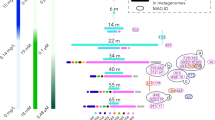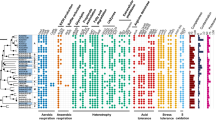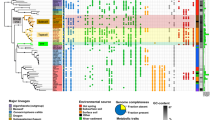Abstract
To probe the metabolic potential of abundant Archaea in boreal peats, we reconstructed two near-complete archaeal genomes, affiliated with Thaumarchaeota group 1.1c (bin Fn1, 8% abundance), which was a genomically unrepresented group, and Thermoplasmata (bin Bg1, 26% abundance), from metagenomic data acquired from deep anoxic peat layers. Each of the near-complete genomes encodes the potential to degrade long-chain fatty acids (LCFA) via β-oxidation. Fn1 has the potential to oxidize LCFA either by syntrophic interaction with methanogens or by coupling oxidation with anaerobic respiration using fumarate as a terminal electron acceptor (TEA). Fn1 is the first Thaumarchaeota genome without an identifiable carbon fixation pathway, indicating that this mesophilic phylum encompasses more diverse metabolisms than previously thought. Furthermore, we report genetic evidence suggestive of sulfite and/or organosulfonate reduction by Thermoplasmata Bg1. In deep peat, inorganic TEAs are often depleted to extremely low levels, yet the anaerobic respiration predicted for two abundant archaeal members suggests organic electron acceptors such as fumarate and organosulfonate (enriched in humic substances) may be important for respiration and C mineralization in peatlands.
Similar content being viewed by others
Log in or create a free account to read this content
Gain free access to this article, as well as selected content from this journal and more on nature.com
or
References
Auguet JC, Barberan A, Casamayor EO . (2010). Global ecological patterns in uncultured Archaea. Isme J 4: 182–190.
Autry AR, Fitzgerald JW . (1990). Sulfonate-S - a Major Form of Forest Soil Organic Sulfur. Biol Fert Soils 10: 50–56.
Basiliko N, Henry K, Gupta V, Moore T, Driscoll B, Dunfield PF . (2013). Controls on bacterial and archaeal community structure and greenhouse gas production in natural,mined, and restored Canadian peatlands. Front Microbiol 4: 215.
Beam JP, Jay ZJ, Kozubal MA, Inskeep WP . (2014). Niche specialization of novel Thaumarchaeota to oxic and hypoxic acidic geothermal springs of Yellowstone National Park. ISME J 8: 938–951.
Berg IA, Ramos-Vera WH, Petri A, Huber H, Fuchs G . (2010). Study of the distribution of autotrophic CO2 fixation cycles in Crenarchaeota. Microbiology+ 156: 256–269.
de la Torre JR, Walker CB, Ingalls AE, Konneke M, Stahl DA . (2008). Cultivation of a thermophilic ammonia oxidizing archaeon synthesizing crenarchaeol. Environ Microbiol 10: 810–818.
Goodchild A, Raftery M, Saunders NF, Guilhaus M, Cavicchioli R . (2004). Biology of the cold adapted archaeon, Methanococcoides burtonii determined by proteomics using liquid chromatography-tandem mass spectrometry. J Proteome Res 3: 1164–1176.
Gorham E . (1991). Northern peatlands: role in the carbon-cycle and probable responses to climatic warming. Ecol Appl 1: 182–195.
Hatzenpichler R, Lebedeva EV, Spieck E, Stoecker K, Richter A, Daims H et al. (2008). A moderately thermophilic ammonia-oxidizing crenarchaeote from a hot spring. Proc Natl Acad Sci USA 105: 2134–2139.
Hawkins AN, Johnson KW, Brauer SL . (2014). Southern Appalachian peatlands support high archaeal diversity. Microb Ecol 67: 587–602.
Kemnitz D, Kolb S, Conrad R . (2007). High abundance of Crenarchaeota in a temperate acidic forest soil. Fems Microbiol Ecol 60: 442–448.
Konneke M, Bernhard AE, de la Torre JR, Walker CB, Waterbury JB, Stahl DA . (2005). Isolation of an autotrophic ammonia-oxidizing marine archaeon. Nature 437: 543–546.
Konneke M, Schubert DM, Brown PC, Hugler M, Standfest S, Schwander T et al. (2014). Ammonia-oxidizing archaea use the most energy-efficient aerobic pathway for CO2 fixation. Proc Natl Acad Sci USA 111: 8239–8244.
Kröger A . (1978). Fumarate as terminal acceptor of phosphorylative electron transport. Biochim Biophys Acta 505: 129–145.
Laderman KA, Davis BR, Krutzsch HC, Lewis MS, Griko YV, Privalov PL et al. (1993). The purification and characterization of an extremely thermostable alpha-amylase from the hyperthermophilic archaebacterium Pyrococcus furiosus. J Biol Chem 268: 24394–24401.
Laue H, Friedrich M, Ruff J, Cook AM . (2001). Dissimilatory sulfite reductase (desulfoviridin) of the taurine-degrading, non-sulfate-reducing bacterium Bilophila wadsworthia RZATAU contains a fused DsrB-DsrD subunit. J Bacteriol 183: 1727–1733.
Lin X, Green S, Tfaily MM, Prakash O, Konstantinidis KT, Corbett JE et al. (2012). Microbial community structure and activity linked to contrasting biogeochemical gradients in bog and fen environments of the glacial lake agassiz peatland. Appl Environ Microbiol 78: 7023–7031.
Lin X, Tfaily MM, Steinweg JM, Chanton P, Esson K, Yang ZK et al. (2014). Microbial community stratification linked to utilization of carbohydrates and phosphorus limitation in a boreal peatland at Marcell Experimental Forest, Minnesota, USA. Appl Environ Microbiol 80: 3518–3530.
Maklashina E, Berthold DA, Cecchini G . (1998). Anaerobic expression of Escherichia coli succinate dehydrogenase: functional replacement of fumarate reductase in the respiratory chain during anaerobic growth. J Bacteriol 180: 5989–5996.
Muller F, Brissac T, Le Bris N, Felbeck H, Gros O . (2010). First description of giant Archaea (Thaumarchaeota) associated with putative bacterial ectosymbionts in a sulfidic marine habitat. Environ Microbiol 12: 2371–2383.
Mussmann M, Brito I, Pitcher A, Sinninghe Damste JS, Hatzenpichler R, Richter A et al. (2011). Thaumarchaeotes abundant in refinery nitrifying sludges express amoA but are not obligate autotrophic ammonia oxidizers. Proc Natl Acad Sci USA 108: 16771–16776.
Pester M, Knorr K-H, Friedrich M, Wagner M, Loy A . (2012). Sulfate-reducing microorganisms in wetlands – fameless actors in carbon cycling and climate change. Front Microbiol 3: 72.
Pilkis SJ, Claus TH . (1991). Hepatic gluconeogenesis/glycolysis: regulation and structure/function relationships of substrate cycle enzymes. Annu Rev Nutr 11: 465–515.
Schink B . (1997). Energetics of syntrophic cooperation in methanogenic degradation. Microbiol Mol Biol Rev 61: 262–280.
Stieglmeier M, Klingl A, Alves RJ, Rittmann SK, Melcher M, Leisch N et al. (2014). Nitrososphaera viennensis gen. nov., sp. nov., an aerobic and mesophilic, ammonia-oxidizing archaeon from soil and a member of the archaeal phylum Thaumarchaeota. Int J Syst Evol Microbiol 64: 2738–2752.
Tourna M, Stieglmeier M, Spang A, Konneke M, Schintlmeister A, Urich T et al. (2011). Nitrososphaera viennensis, an ammonia oxidizing archaeon from soil. Proc Natl Acad Sci USA 108: 8420–8425.
Acknowledgements
We thank Randall K. Kolka, USDA Forest Service, Paul J. Hanson, Colleen Iversen and other members of the SPRUCE project team for facilitating access to the Marcell Experimental Forest and the SPRUCE experimental facilities, and for helping with sample handling and laboratory space support. We thank P. Chanton and K. Esson for peat soil sampling, and S. Owens for the Illumina library preparation and sequencing. We acknowledge the University of Chicago Research Computing Center for support of this work. This work was supported by the Office of Biological and Environmental Research, Terrestrial Ecosystem Science Program, under U.S. DOE contracts DE-SC0007144 and DE-SC0012088, the U.S. National Science Foundation (NSF-EAR-0628349), and in part by the U.S. DOE contract DE-AC02-06CH11357. We wish to thank the generous support of the Alfred P Sloan Foundation.
Author information
Authors and Affiliations
Corresponding authors
Ethics declarations
Competing interests
The authors declare no conflict of interest.
Additional information
Supplementary Information accompanies this paper on The ISME Journal website
Rights and permissions
About this article
Cite this article
Lin, X., Handley, K., Gilbert, J. et al. Metabolic potential of fatty acid oxidation and anaerobic respiration by abundant members of Thaumarchaeota and Thermoplasmata in deep anoxic peat. ISME J 9, 2740–2744 (2015). https://doi.org/10.1038/ismej.2015.77
Received:
Revised:
Accepted:
Published:
Issue date:
DOI: https://doi.org/10.1038/ismej.2015.77
This article is cited by
-
Diverse ecophysiological adaptations of subsurface Thaumarchaeota in floodplain sediments revealed through genome-resolved metagenomics
The ISME Journal (2022)
-
Community structure and activity potentials of archaeal communities in hadal sediments of the Mariana and Mussau trenches
Marine Life Science & Technology (2022)
-
Biohythane production from tofu processing residue via two-stage anaerobic digestion: operational conditions and microbial community dynamics
Biomass Conversion and Biorefinery (2022)
-
Bacterial and archaeal communities in deep sea waters near the Ninetyeast Ridge in Indian Ocean
Journal of Oceanology and Limnology (2021)
-
Characterization of microbial communities in sediments of the South Yellow Sea
Journal of Oceanology and Limnology (2021)



